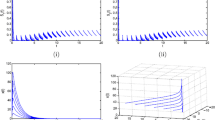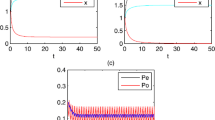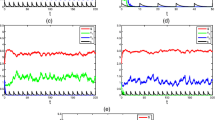Abstract
In this paper, we consider a new Monod type chemostat model with time delay and impulsive input concentration of the nutrient in a polluted environment. Using the discrete dynamical system determined by the stroboscopic map, we obtain a “microorganism-extinction” periodic solution. Further, we establish the sufficient conditions for the global attractivity of the microorganism-extinction periodic solution. Using new computational techniques for impulsive and delayed differential equation, we prove that the system is permanent under appropriate conditions. Our results show that time delay is “profitless”.
Similar content being viewed by others
References
Hsu S B. A competition model for a seasonally fluctuating nutrient[J]. Journal of Mathematical Biology, 1980, 9(2):115–132.
Smith H L. Competitive coexistence in an oscillating chemostat[J]. SIAM Journal on Applied Mathematics, 1981, 40(3):498–522.
Butler G J, Hsu S B, Waltman P. A mathematical model of the chemostat with periodic washout rate[J]. SIAM Journal on Applied Mathematics, 1985, 45(3):435–449.
Pilyugin S S, Waltman P. Competition in the unstirred chemostat with periodic input and washout[J]. SIAM Journal on Applied Mathematics, 1999, 59(4):1157–1177.
Simth H L, Waltman P. The theory of the chemostat[M]. Cambridge: Cambridge University Press, 1995.
Hsu S B, Hubbell S P, Waltman P. A mathematical theory for single nutrient competition in continuous cultures of micro-organisms[J]. SIAM Journal on Applied Mathematics, 1977, 32(2):366–382.
Picket A M. Growth in a changing environment[M]. In: Bazin M J (ed). Microbial Population Dynamics, Florida: CRC Press, 1982.
Monod J. La technique de culture continue; théorie et applications[J]. Ann Inst Pasteur, 1950, 79(19):390–401.
Hansen S R, Hubbell S P. Single-nutrient microbial competition: qualitative agreement between experimental and theoretically forecast outcomes[J]. Science, 1980, 207(4438):1491–1493.
Barford J P, Pamment N B, Hall R J. Lag phases and transients[M]. In: Bazin M J (ed). Microbial Population Dynamics, Florida: CRC Press, 1982.
Ramkrishna D, Fredrickson A G, Tsuchiya H M. Dynamics of microbial propagation: models considering inhibitors and variable cell composition[J]. Biotechnology and Bioengineering, 1967, 9(2):129–170.
Bush A W, Cook A E. The effect of time delay and growth rate inhibition in the bacterial treatment of wastewater[J]. Journal of Theoretical Biology, 1976, 63(2):385–395.
Caperon J. Time lag in population growth response of isochrysis galbana to a variable nitrate environment[J]. Ecology, 1969, 50(2):188–192.
Freedman H I, So J W-H, Waltman P. Coexistence in a model of competition in the chemostat incorporating discrete delays[J]. SIAM Journal on Applied Mathematics, 1989, 49(3):859–870.
Freedman H I, So J W-H, Waltman P. Chemostat competition with time delays[M]. In: Eisenfeld J, Levine D S (eds). Biomedical Modelling and Simulation, New York: Scientific Publishing Co, 1989.
Ruan Shi-gui, Wolkowicz Gail S K. Bifurcation analysis of a chemostat model with a distributed delay[J]. Journal of Mathematical Analysis and Applications, 1996, 204(3)786–812.
Thingstad T F, Langeland T I. Dynamics of chemostat culture: the effect of a delay in cell response[J]. Journal of Theoretical Biology, 1974, 48(1):149–159.
Ellermeyer S F. Competition in the chemostat: global asymptotic behavior of a model with delayed response in growth[J]. SIAM Journal on Applied Mathematics, 1994, 54(2):456–465.
Wolkowicz Gail S K, Xia H. Global asymptotic behavior of a chemostat model with discrete delays[J]. SIAM Journal on Applied Mathematics, 1997, 57(4):1019–1043.
Wolkowicz Gail S K, Xia Hua-xing, Ruan Shi-gui. Competition in the chemostat: a distributed delay model and its global asymptotic behavior[J]. SIAM Journal on Applied Mathematics, 1997, 57(5):1281–1310.
Xia Hua-xing, Wolkowicz Gail S K, Wang Lin. Transient oscillations induced by delayed growth response in the chemostat[J]. Journal of Mathematical Biology, 2005, 50(5):489–530.
Zhao Tao. Global periodic solutions for a differential delay system modelling a microbial population in the chemostat[J]. Journal of Mathematical Analysis and Applications, 1995, 193(1):329–352.
MacDonald N. Time delays in chemostat models[M]. In: Bazin M J (ed). Microbial Population Dynamics, Florida: CRC Press, 1982.
Hale J K, Somolinas A S. Competition for fluctuating nutrient[J]. Journal of Mathematical Biology, 1983, 18(3):255–280.
Buler G J, Hsu S B, Waltman P. A mathematical model of the chemostat with periodic washout rate[J]. SIAM Journal on Applied Mathematics, 1985, 45(3):435–449.
Wolkowicz Gail S K, Zhao Xiao-qiang. N-spicies competition in a periodic chemostat[J]. Differential and Integral Equations: An International Journal for Theory and Applications, 1998, 11(3):465–491.
Funasaki E, Kot M. Invasion and chaos in a periodically pulsed mass-action chemostat[J]. Theoretical Population Biology, 1993, 44(2):203–224.
Smith R J, Wolkowicz Gail S K. Analysis of a model of the nutrient driven self-cycling fermentation process[J]. Dynamics of Continuous, Discrete and Impulsive Systems, Series B, 2004, 11(2):239–265.
Sun Shu-lin, Chen Lan-sun. Dynamic behaviors of Monod type chemostat model with impulsive perturbation on the nutrient concentration[J]. Journal of Mathematical Chemistry, 2007, 42(4):837–848.
Bainov D, Simeonov P. Impulsive differential eqations: periodic solutions and applications[M]. Harlow: Longman Scientific and Technical Press, 1993.
Lakshmikantham V, Bainov D, Simeonov P. Theory of impulsive differential equations[M]. Singapore: World Scientific, 1989.
Liu Xian-ning, Chen Lan-sun. Complex dynamics of Holling type II Lotka-Volterra predator-prey system with impulsive perturbations on the predator[J]. Chaos, Solitons and Fractals, 2003, 16(2):311–320.
Roberts M G, Kao R R. The dynamics of an infectious disease in a population with birth pulses[J]. Mathematical Biosciences, 1998, 149(1):23–36.
Ballinger G, Liu X. Permanence of population growth models with impulsive effects[J]. Mathematical and Computer Modelling, 1997, 26(12):59–72.
Sun Ming-jing, Chen Lan-sun. Analysis of the dynamical behavior for enzyme-catalyzed reactions with impulsive input[J]. Journal of Mathematical Chemistry, 2006, DOI: 10.1007/s10910-006-9207-5.
Chen Lan-sun, Chen Jian. Nonlinear biological dynamic systems[M]. Beijing: Science Press, 1993 (in Chinese).
Kuang Yang. Delay differential equations with applications in population dynamics[M]. California: Academic Press Inc, 1993.
Author information
Authors and Affiliations
Corresponding author
Additional information
Communicated by GUO Xing-ming
Project supported by the National Natural Science Foundation of China (Nos. 10471117 and 10771179) and the Natural Science Foundation of Shandong University of Science and Technology (No. 05g016)
Rights and permissions
About this article
Cite this article
Meng, Xz., Zhao, Ql. & Chen, Ls. Global qualitative analysis of new Monod type chemostat model with delayed growth response and pulsed input in polluted environment. Appl. Math. Mech.-Engl. Ed. 29, 75–87 (2008). https://doi.org/10.1007/s10483-008-0110-x
Received:
Revised:
Issue Date:
DOI: https://doi.org/10.1007/s10483-008-0110-x




